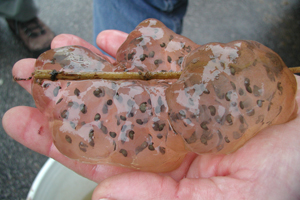 Mixing it up: Alternative strategies for reproduction in amphibians
Mixing it up: Alternative strategies for reproduction in amphibians
>Everyone knows that amphibians spend part of their lives in water and part on land—that description is clear from their name–“amphi”, meaning “of both kinds”, and “bios”, meaning “life”. Eggs are laid in the water, and after spending some time as aquatic larvae, they turn into terrestrial adults, right? Not so fast. Amphibian lifestyles are much more complex than you think. Even in North America, some species lay their eggs on land and have tiny offspring that look just like miniature adults. Others never leave the water, even as adults. And in other parts of the world, the different reproductive strategies seem endless! Amphibians have more flexibility in their reproductive strategies than any other group of vertebrates.
>On Oct 16, Dr. Megan Gibbons will present some of the amazing reproductive adaptations of amphibians, including frog embryos in trees that can detect and escape snake predation, adults that tote their tadpoles from nests to nurseries, and moms who swallow eggs and rear their young in their stomachs. Who knew amphibians had so many options?
>Dr. Gibbons is a Professor of Biology at Birmingham-Southern College. Her areas of research include amphibian ecology and behavior, particularly heritability of behavior and maternal investment. She earned her B. A. from Emory University and her M. S. and Ph.D. from University of Louisiana at Lafayette.
